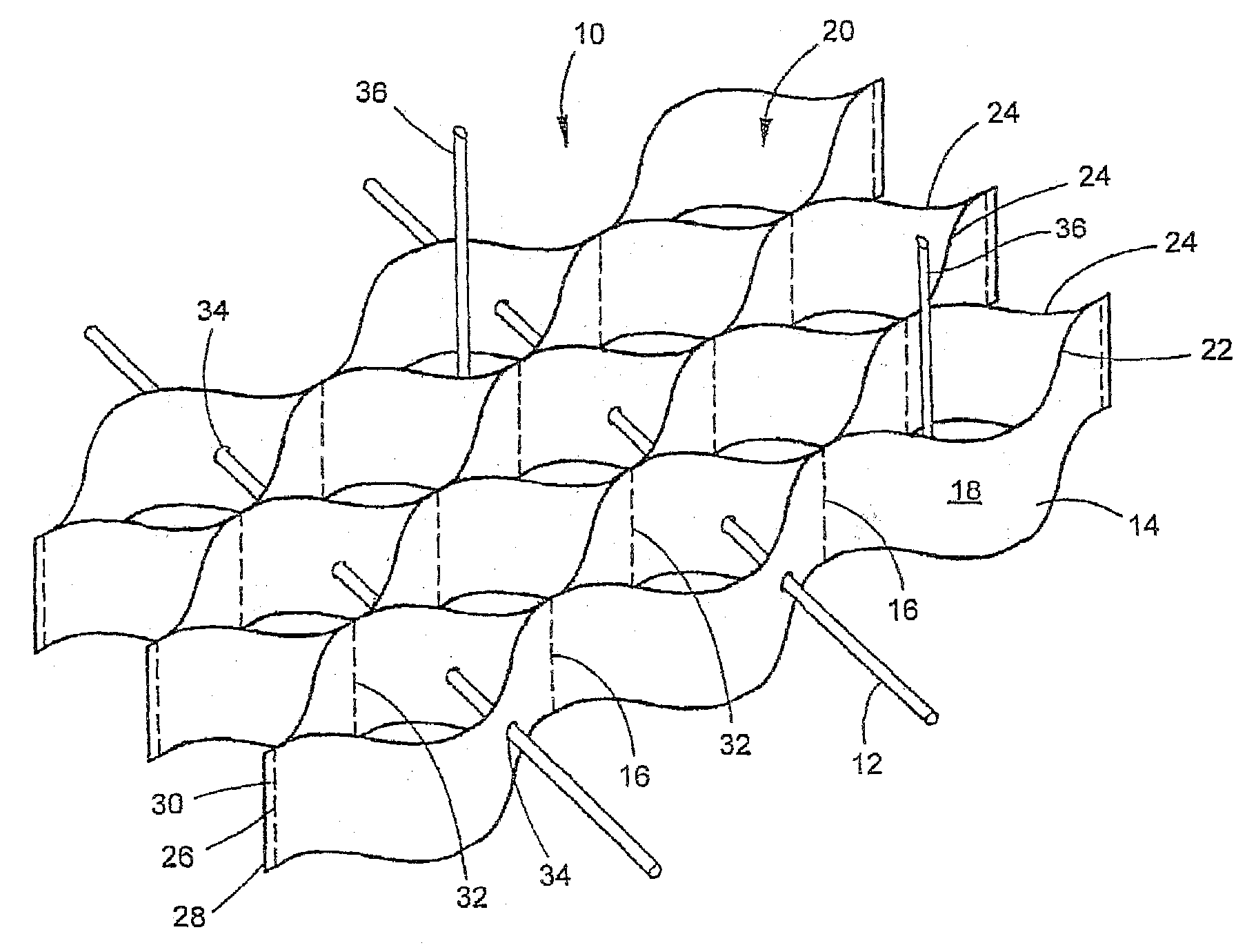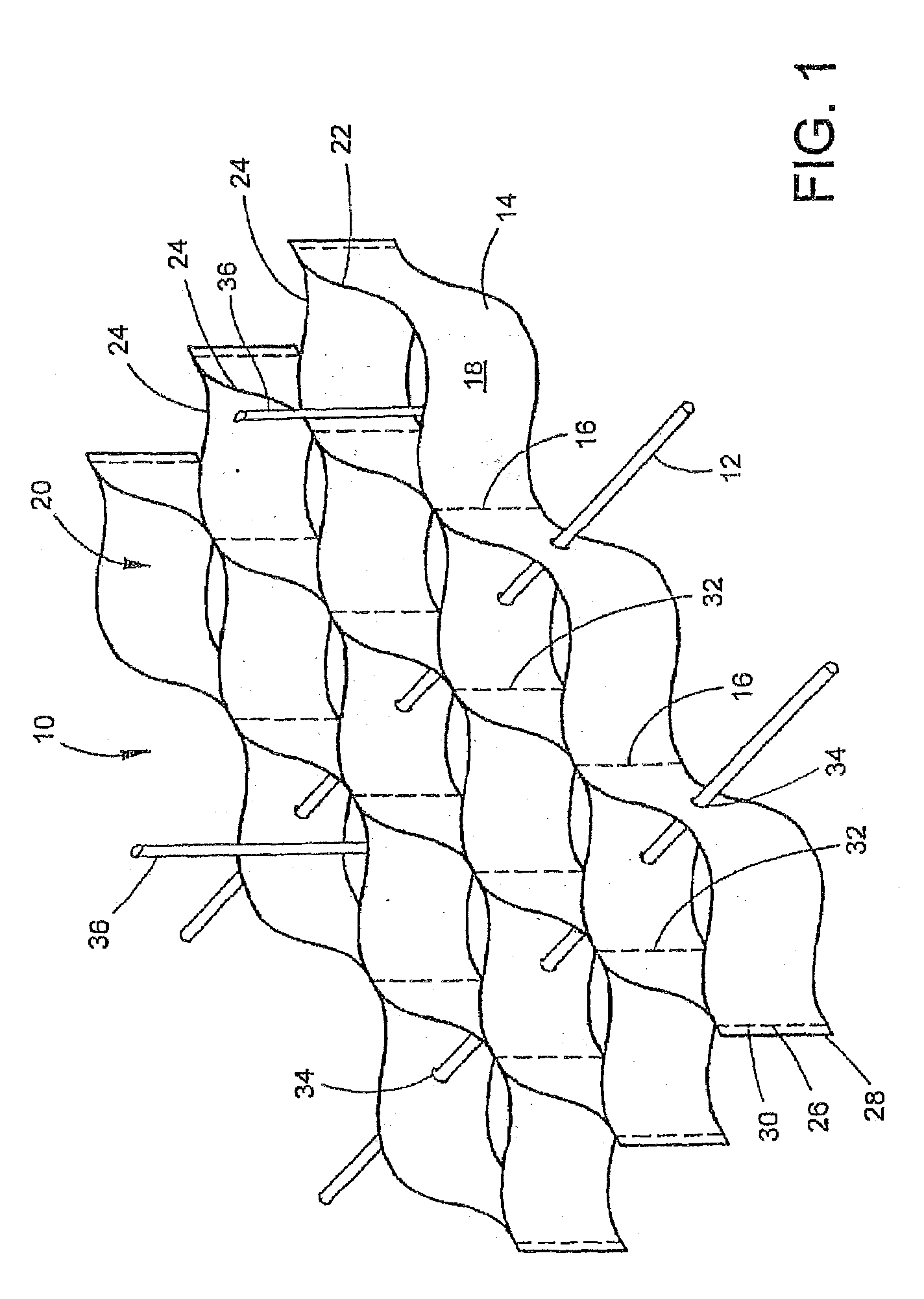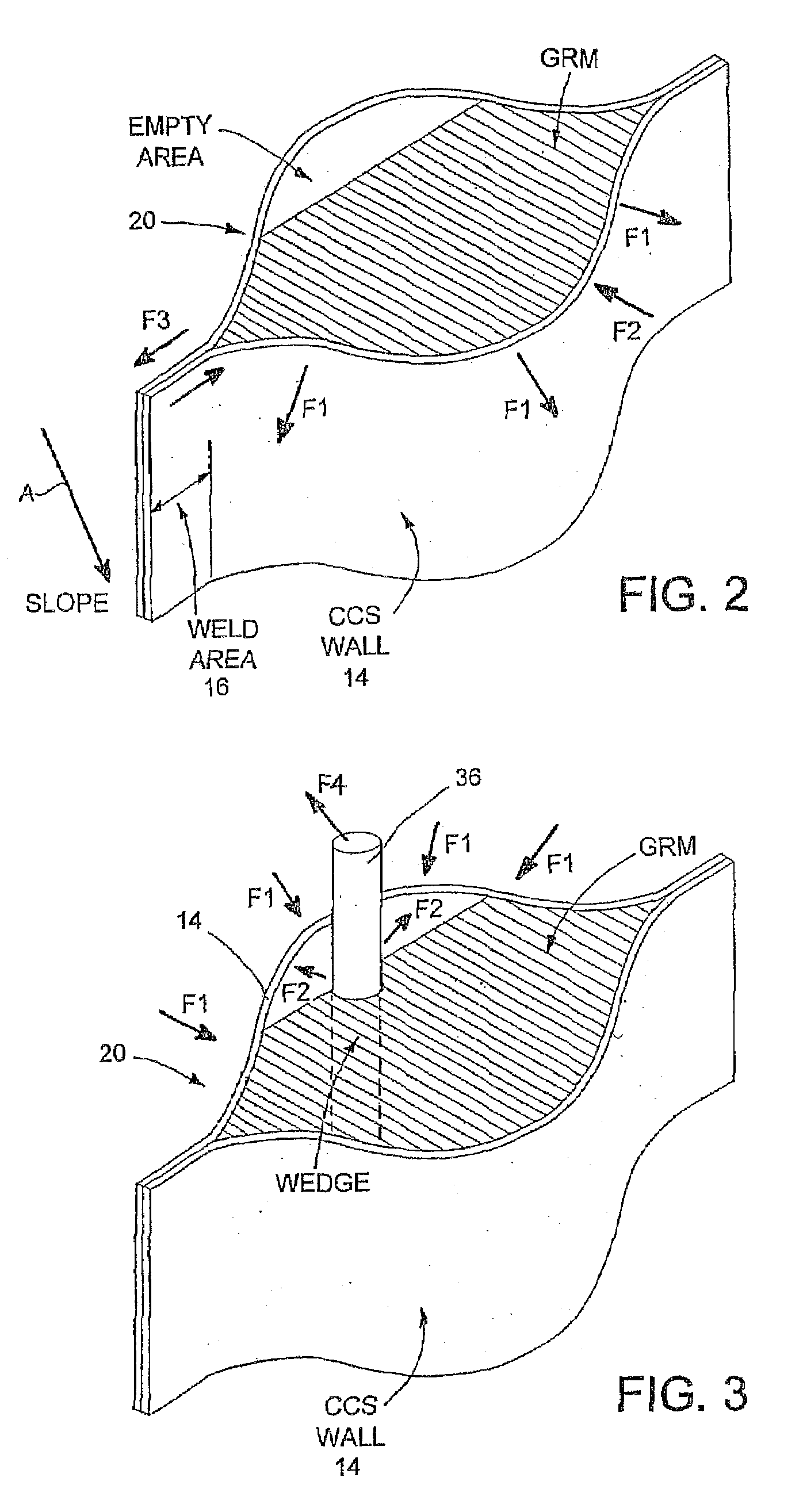If the CCS wall is too flexible, it will collapse during installation in the field, for example when humans walk over the CCS before it is filled with GRM or during the filling and condensing of GRM in the CCS cells.
However, installation becomes difficult and sometimes impossible at subzero temperatures, especially temperatures below minus 10° C. HDPE also has high tendency to
creep at temperatures of about +40° C. and over.
At temperatures lower than minus 10° C., these polymers are no longer tough and ductile, but fragile and brittle.
Creep of the CCS wall causes loosening of the friction and loss of structural functionality of the CCS-GRM
composite structure.
Anytime the load transfer between those two components is breached—due to
cell wall
creep, rupture or irreversible deformation—the filled CCS structure loses its integrity and cannot provide the required structural strength, dimensional stability and stiffness.
The mechanism of failure of CCSs made from HDPE at sub-zero temperatures is complex.
When the stress is applied for many days at temperatures lower than minus 15° C., the
toughness of the HPDE or MDPE is insufficient and a brittle failure occurs.
Since crack growth resistance (
toughness) of HDPE and MDPE is medium or even low relative to LLDPE or elastomers at those temperatures, the CCS breaks and loses its integrity.
However, if LLDPE or elastomers are used as the matrix of the CCS, then the CCS severely creeps at temperatures greater than 40° C. Thus, the repeated cycles of heating, expansion of the CCS,
resultant spreading or collapse of the GRM structure previously contained by the CCS, results in eventual failure or significant loss of function of the CCS.
In particular, this
brittleness critically affects the weld points between the plurality of strips.
Because the connection points between the CCS and the anchors, tendons, and / or wedges have high loads concentrated in a small area, failure is most likely to happen at these
stress concentration points, especially under extreme conditions such as subzero temperatures or temperatures higher than about 40° C.
HDPE also has relatively poor stress
cracking resistance, medium to low tear and
puncture resistance, and low crack growth resistance—especially at subzero temperatures.
Cracks are initiated in geotechnical applications during application and installation, and during service, especially when dynamic loads are applied.
Since the
brittleness increases in a “quasi-exponential” fashion as temperature drops, reinforcing articles comprising HDPE as the major constituent are subjected to
catastrophic failure at subzero (° C.) temperatures.
Again, failure is more likely to happen at the weld points and at the contact points between the CCS and wedges, anchors, and tendons.
However, they have very poor
creep resistance at temperatures higher than ambient, and especially higher than 40° C. Such high temperatures are expected in
arid and tropic areas, but are also reached in cold areas (e.g., during the summer).
Another drawback of relatively flexible polymers (such as LLDPE) is that they lack the stiffness needed when the CCS cells are still empty and humans need to walk on it during installation or during filling and compaction of GRM.
If the CCS wall is too flexible, it will collapse during installation in the field, especially during the filling and condensing of GRM in the CCS cells.
They also tend to creep under load, so that the connection points to anchors, tendons, and / or wedges get loose over time in elevated temperatures.
This creep undermines the integrity of the CCS.
These polymers are made in a reactor and thus very limited in composition flexibility.
If a more rubbery phase is required, it cannot be made in a reactor.
The compositions described in this patent are not applicable for structural geotechnical applications including CCSs, due to its inherent brittleness, especially at low temperatures, and lack of protection against
humidity and UV light.
This patent does not deal with either the difficulties in
welding of the compositions, or the hydrolytic
instability of the
polyamide phase, which may be hydrolyzed in soil, especially acidic soils.
However, LLDPE itself does not provide adequate flexibility at low temperatures.
Blending in standard manufacturing equipment does not provide the morphology that is required for long-term stability when the temperature of the exposed plastic can vary from minus 70° C. to +90° C. This is a problem especially in cold areas where during autumn and winter, the temperature of exposed plastics may drop below minus 40° C., but during summer, when direct
sunlight is absorbed by the CCS surface, temperatures may exceed +90° C.
Other drawbacks related to this mixing of two polyethylenes for geotechnical articles are the still high CTE (higher than about 150 ppm / ° C.
Consequently, in
extrusion applications, for example
extrusion of strips for geotechnical applications, flow of the melt is uneven (melt fracturing), and segregation between phases is observed.
The compositions described in this patent are not applicable for structural geotechnical applications including CCSs, due to their flexibility and creep tendency.
The patent also does not provide a solution for the protection of the blend from
hydrolysis in soils and landfills, oils and hydrocarbons, and from the degradation induced by heat and UV light.
Another drawback is that LLDPE is not flexible enough and lacks the required
toughness when it reaches temperatures lower than minus 40° C.
PP is too rigid and lacks the flexibility at temperatures below about 0° C., a property that is mandatory in CCSs.
The compatibilizer in this patent is
styrene-based and thus has limited UV light resistance, limiting the composition lifetime to about 1 to 2 years.
Polyester blends, especially when not specially stabilized against
hydrolysis, may fail in soils, especially those having pH greater than 7, within a relatively short period of time.
Another drawback is that the blend is not flexible enough and lacks the required toughness when it reaches temperatures lower than minus 40° C.
The incorporation of the more amorphous LLDPE into the HDPE resin provides crack stop mechanisms, but no solution is provided for CCS systems where strength is crucial and creep must be minimized—especially at temperatures greater than 40° C. Moreover, no solution is provided for subzero temperatures such as temperatures below minus 15° C. or minus 40° C. Since CCSs are a
composite structure comprising strips and weld lines, mixing two different polyethylenes may negatively affect
welding strength and long-term durability as well.
It is also not straightforward to disperse the relatively viscous LLDPE in an HDPE matrix, especially by means of conventional extrusion equipment.
The high flexibility that is an
advantage in geomembranes becomes a drawback in CCS: when load is applied on CCS supporting GRM, the
composite structure of the two components interacts with the load as an integrated
system.
At that specific state, the integrated
system is irreversibly damaged and can no longer provide the required durability, stiffness and stabilization to the GRM.
The patent does not provide a solution to the
hydrolysis of the composition in soils and landfills, or when exposed to concrete or other media characterized by pH of greater than 7.
The flexible blend has a CTE greater than 150 ppm / ° C. and also does not provide sufficient toughness at temperatures lower than minus 40° C.
 Login to View More
Login to View More 


